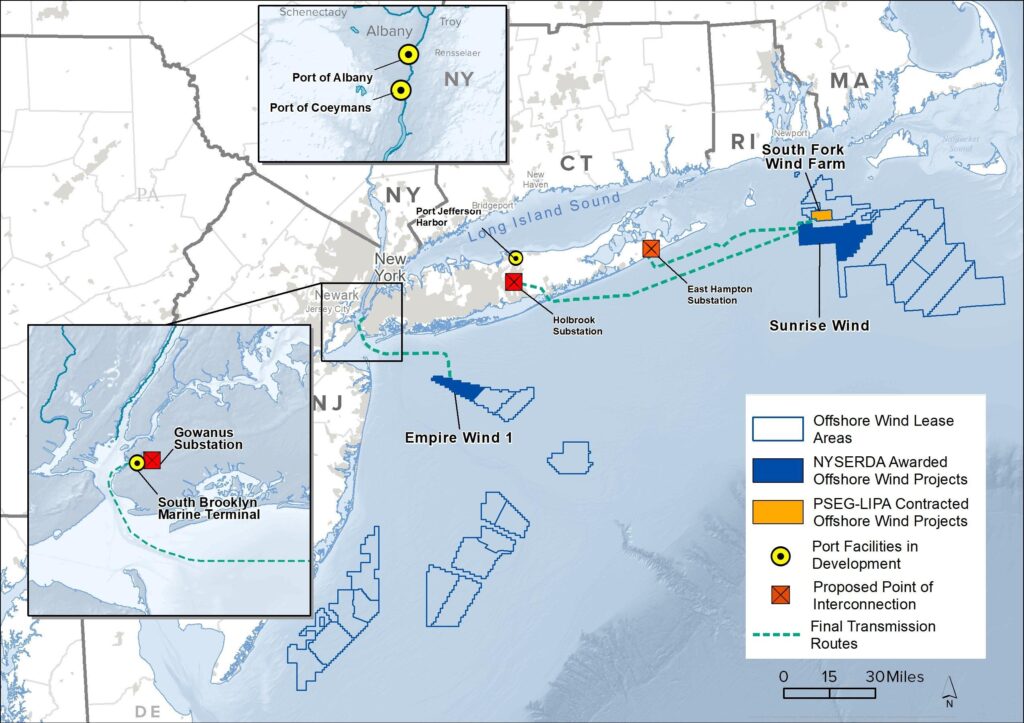New York’s Offshore Wind Revival: Political Claims and Renewable Energy Progress
In an unusual alignment of political agendas, New York City Mayor Eric Adams and Governor Kathy Hochul have both stepped forward to assert their influence over the federal government’s recent decision to reactivate a significant offshore wind farm project. Originally suspended during the previous administration, this initiative marks a pivotal advancement in New York’s ambitious renewable energy strategy. As the project gains renewed traction, both leaders emphasize their distinct contributions, reflecting the intricate relationship between environmental policy and political leadership within the state.
Mayor Adams Champions Grassroots Advocacy in Wind Farm Reinstatement
Mayor Adams credits the persistent efforts of local stakeholders as crucial to the wind farm’s comeback, despite earlier resistance from community groups and environmental watchdogs. At a recent media briefing, he underscored the synergy between city officials, environmental experts, and neighborhood representatives who collaboratively addressed concerns such as wildlife protection and noise disturbances. Adams argues that this foundational work was instrumental in influencing higher-level political decisions to revive the project.
He highlighted several areas where local initiatives have yielded measurable results:
- Robust Community Involvement: Conducting over 30 inclusive public meetings to gather diverse perspectives
- Advanced Environmental Protections: Deploying cutting-edge turbine designs to reduce ecological footprint
- Economic Revitalization: Generating employment opportunities and positioning New York City as a leader in renewable energy innovation
While Mayor Adams welcomes recognition from state and federal officials, he maintains that the city’s dedicated groundwork remains the primary catalyst for the project’s resurgence. This stance contrasts with competing claims, illustrating the ongoing contest over political credit for the wind farm’s revival.
Governor Hochul Highlights Statewide Economic Advantages Amid Political Contest
Governor Hochul has focused on the broad economic benefits the wind farm project promises for New York State. Following the reversal of prior restrictions under the Trump administration, her office emphasized the initiative’s capacity to create thousands of jobs and deliver long-term energy cost savings across both urban centers and rural communities. Hochul pointed to the project’s potential to stimulate growth in manufacturing, infrastructure development, and the clean energy sector statewide.
Despite the Governor’s emphasis on collective prosperity, Mayor Adams continues to assert his pivotal role in advocating for the project’s reinstatement. Both leaders have publicly showcased their achievements, yet the underlying narrative remains a political rivalry over leadership in New York’s clean energy transition.
- Generation of quality employment in construction and renewable energy industries
- Advancement of New York’s carbon reduction targets aligned with state climate policies
- Strengthening economic resilience through sustainable infrastructure investments
| Economic Factor | Projected Impact |
|---|---|
| Employment Opportunities | Over 2,000 direct and indirect jobs anticipated |
| Renewable Energy Production | Enough to power approximately 50,000 households annually |
| Capital Investment | Estimated $150 million infusion into the economy |
Evaluating the Effects of the Federal Reinstatement on New York’s Clean Energy Future
The federal government’s decision to reinstate the offshore wind project, initially halted under the Trump administration, has sparked contrasting narratives between Albany and New York City. Both Mayor Adams and Governor Hochul have independently claimed credit for influencing this pivotal move, highlighting the high stakes involved in New York’s renewable energy expansion. Their competing assertions reveal the complex interplay of federal, state, and local interests in shaping the state’s environmental and economic trajectory.
Key impacts of the project’s revival include:
- Revitalization of local economies through the creation of clean energy jobs
- Acceleration of New York’s greenhouse gas reduction goals in line with the Climate Leadership and Community Protection Act (CLCPA)
- Strengthening of public-private collaborations to foster innovation in offshore wind technologies
| Impact Category | Expected Result | Primary Beneficiaries |
|---|---|---|
| Job Creation | More than 5,000 new employment opportunities | Local Workforce |
| Carbon Emissions Reduction | Cutting 1.2 million tons of CO₂ annually | Environmental Advocates |
| Infrastructure Investment | $1.5 billion allocated for development | State Government & Private Sector |
Strategies for Harmonizing Environmental Ambitions with Community Interests
To ensure sustainable progress without alienating local populations, policymakers must foster transparent communication and inclusive participation from the outset. Early engagement with community members helps align environmental objectives with local priorities and mitigates opposition. Approaches such as public consultations, advisory panels, and ongoing feedback mechanisms can effectively bridge the divide between green energy initiatives and community concerns, resulting in more durable and widely supported wind farm projects.
Additionally, adopting flexible planning frameworks allows for adjustments based on continuous environmental assessments and community input. The following table outlines essential policy components that balance ecological benefits with social acceptance:
| Policy Component | Community Advantage | Environmental Benefit |
|---|---|---|
| Proactive Public Engagement | Builds trust and ensures transparency | Identifies and addresses local environmental concerns |
| Local Hiring Incentives | Stimulates economic growth and job creation | Reduces resistance by fostering community support |
| Continuous Environmental Monitoring | Maintains accountability and public confidence | Protects biodiversity and ecosystem health |
- Educational outreach programs to raise awareness about renewable energy benefits.
- Adaptive mitigation strategies responsive to community feedback.
- Regular progress reports to sustain transparency and engagement.
By implementing these comprehensive measures, leaders can advance offshore wind projects that not only meet environmental targets but also respect and empower the communities they impact.
Conclusion: Navigating Political Narratives While Advancing Clean Energy
The ongoing debate over the Trump administration’s role in reinstating New York’s offshore wind project highlights the complex political dynamics between Mayor Adams and Governor Hochul, each asserting leadership in the state’s renewable energy progress. Despite these competing claims, the renewed focus on offshore wind power underscores New York’s unwavering commitment to a sustainable energy future. As political lines blur, the state moves forward in harnessing clean energy to power its economy and protect the environment for generations to come.













